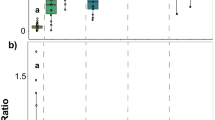Summary
Experiments were performed to measure the pH-sensitive steps in nodulation and symbiotic fixation byPisum sativum and isolate RP-212-1 ofRhizobium leguminosarum. An aeroponic system with rigorous pH control was used to obtain numerous effective nodules. After exposure to various pH levels, the following responses were measured: (1) legume root growth and development, (2) survival and growth rate of a single effective bacterial isolate, (3) degree of nodulation, (4) rate of nitrogen fixation, (5) plant biomass, and (6) nitrogen content of plants. Both bacterial growth and root development were adequate at all pH levels from 4.4 to 6.6, but efficient nodulation and nitrogen fixation did not occur at pH 4.8 and below. The processes required for symbiosis were about 10 times as sensitive to acidity as either bacterial growth or root growth alone. Nodulation was the most acid-sensitive step.
Similar content being viewed by others
References
Albrecht, W. A. and Davis, F. L. 1929 Physiological importance of calcium in legume inoculation. Bot. Gaz.88, 310–321.
Francis, A. J. 1971 A Comparison of effective and ineffective associations in the Rhizobium legume symbiosis. Ph.D. Diss., Cornell Univ.
Harper, J. E. and Nicholas, J. C. 1976 Control of nutrient solution pH with an ion exchange system: Effect on soybean nodulation. Physiol. Plant.38, 24–28.
Jensen, W. A. 1962 Botanical Histochemistry. W. H. Freeman & Co., San Francisco, CA. pp. 408.
Lie, T. A. 1969 The effect of low pH on different phases of nodule formation in pea plants. Plant and Soil31, 391–406.
Loneragan, J. F. and Dowling, E. J. 1958 The interation of calcium and hydrogen ions in the nodulation of subterranean clover. Aust. J. Agric. Res.9, 464–472.
Munns, D. N. 1968 Nodulation ofMedicago sativa in solution culture. I. Acid sensitive steps. Plant and Soil28, 129–146.
Munns, D. N. 1970 Nodulation ofMedicago sativa in solution culture. V. Calcium and pH requirements during infection. Plant and Soil32, 90–102.
Quispel, A. 1974 General Introduction, The Biology of Nitrogen Fixation. Ed. A. Quispel. Frontiers of Biology North-Holland Research Monographs, Vol.33, North-Holland Publ. Co., Amsterdam. 753 p.
Schwinghamer, E. A. 1960 Studies on induced variation in the Rhizobia. I. Defined media and nodulation test techniques. Appl. Microbiol.8, 349–352.
Small, J. G. 1968 Physiological studies on the genusTrifolium with special reference to the South African species. IV. Effect of calcium and pH on growth and nodulation. S. Afr. J. Agric. Sci.11, 441–458.
Zobel, R. W., Del Tredici, P. and Torrey, J. G. 1976 Method for growing plants aeroponically. Plant Physiol.57, 344–346.
Author information
Authors and Affiliations
Rights and permissions
About this article
Cite this article
Evans, L.S., Lewin, K.F. & Vella, F.A. Effect of nutrient medium pH on symbiotic nitrogen fixation byRhizobium leguminosarum andPisum sativum . Plant Soil 56, 71–80 (1980). https://doi.org/10.1007/BF02197954
Received:
Issue Date:
DOI: https://doi.org/10.1007/BF02197954




